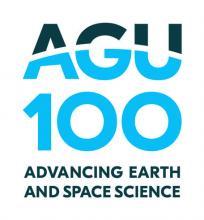| Monday |
|
December 9, 2019 |
|
|
| 09:30 - 09:45 |
Moscone South - 205-206, L2 |
SA11A-07 - Observations of pole-to-pole, stratosphere-to-ionosphere connection |
Larisa Goncharenko (MIT Haystack) |
|
| 08:00 - 12:20 |
Moscone South - Poster Hall |
SM11C-3301 - An examination of sub-auroral ionospheric convection using SuperDARN and AMPERE |
Bharat Kunduri KK4DZY (Virginia Tech) |
VT SuperDARN |
| 08:00 - 12:20 |
Moscone South - Poster Hall |
SM11B-3290 - Observations of Ground-level Auroral Kilometric Radiation and its relationship to simultaneous AKR observed with the Geotail and Cluster satellites |
James LaBelle (Dartmouth) |
|
| Tuesday |
|
December 10, 2019 |
|
|
| 08:30 - 08:45 |
Moscone South - 207, L2 |
SM21A-03 - New STEVE phenomena characterization and database by ‘professional-amateur’ collaborative Heliophysics |
Elizabeth MacDonald (NASA) |
Aurorasaurus |
| 09:00 - 09:15 |
Moscone South - 207, L2 |
SM21A-05 - Some Recent Observational and Theoretical Progress in Understanding Inner Magnetosphere Plasma Transport Dynamics (Invited) |
Phil Erickson W1PJE (MIT Haystack) |
|
| 11:30 - 11:40 |
Moscone South - 205-206, L2 |
SA22A-08 - A Traveling Ionospheric Disturbance Activity Index |
Anthea Coster (MIT Haystack) |
|
| 13:40 - 18:00 |
Moscone South - Poster Hall |
SA33B-3136 - Improvements to SuperDARN convection analysis and observation techniques |
William Bristow (U Alaska Fairbanks) |
UAF SuperDARN |
| Wednesday |
|
December 11, 2019 |
|
|
| 11:50 - 12:00 |
Moscone South - 215, L2 |
ED32A-10 - Towards developing appropriate and diverse metrics for citizen science – a case study |
Elizabeth MacDonald (NASA) |
Aurorasaurus |
| 08:00 - 12:20 |
Moscone South - Poster Hall |
A31U-2759 - Airborne Weather Station And Amateur Radio Repeater For Disaster Response |
Gabriel Ladd KN4UJK |
|
| Thursday |
|
December 12, 2019 |
|
|
| 10:20 - 10:50 |
Moscone South - 104-105, LLS |
TT42A - The Stories of STEVE, Community Science, and Disruptive Innovation |
Elizabeth MacDonald (NASA) |
Aurorasaurus |
| 11:20 - 11:35 |
Moscone South - 208, L2 |
SH42A-05 - Stealthy Coronal Mass Ejections and High Speed Streams: A Recipe for Surprisingly Geoeffective Events at 1 AU |
Tamitha Skov WX6SWW (Aerospace Corp) |
|
| 08:00 - 12:20 |
Moscone South - Poster Hall |
SH41E-3297 - Design, Testing, and Implementation of the Marshall Grazing Incidence X-ray Spectrometer Slit-Jaw Context Imaging System |
Phillip Wilkerson KM4LVC (U Alabama Huntsville) |
|
| 13:40 - 18:00 |
Moscone South - Poster Hall |
SA43C-3213 - A Low-Cost HamSCI Citizen Science HF Doppler Receiver for Measuring Ionospheric Variability |
David Kazdan AD8Y and Kristina Collins KD8OXT (CWRU) |
PSWS |
| 13:40 - 18:00 |
Moscone South - Poster Hall |
SA43C-3234 - SuperDARN echo occurrence during “Steve” events |
Gareth Perry KD2SAK (NJIT) |
|
| |
Moscone South - eLightning Theater III |
SA44A-07 - Exploring Earth’s High Latitude Aurora in Radio: The AERO and VISTA Cubesat Missions |
Phil Erickson W1PJE (MIT Haystack) |
|
| Friday |
|
December 13, 2019 |
|
|
| 10:20 - 10:32 |
Moscone South - 203-204, L2 |
SA52A-01 - Large Scale Traveling Ionospheric Disturbances Observed using HamSCI Amateur Radio, SuperDARN, and GNSS TEC |
Nathaniel Frissell W2NAF (U Scranton) |
TIDs |
| 16:00 - 16:15 |
Moscone South - 203-204, L2 |
SA54A-01 - TID wavelength control of disturbance features in quasi-vertically incident ionograms (Invited) |
Manuel Cervera (DST) |
TIDs |
| 08:00 - 12:20 |
Moscone South - Poster Hall |
SA51C-3176 - Examining the Role of Dispersion Relation and Collision Frequency Formulations on Estimation of Shortwave–Fadeout |
Shibaji Chakraborty KN4BMT (Virginia Tech) |
Solar Flare Effects |
| 08:00 - 12:20 |
Moscone South - Poster Hall |
SM51E-3239 - Statistical Study of Open Closed Boundaries (OCB) using ULF Wave Observations from Antarctic AGOs, McMurdo Station, and South Pole Station |
Rachel Frissell W2RUF (NJIT) |
|
| 08:00 - 12:20 |
Moscone South - Poster Hall |
SA51C-3173 - Propagation Teepee: A High Frequency (HF) Radio Spectral Feature Identified by Citizen Scientists |
Shing Fung (NASA) |
RadioJove |
| 08:00 - 12:20 |
Moscone South - Poster Hall |
SM51I-3297 - Observations of Particle Loss due to Injection-Associated EMIC Waves |
Hyomin Kim KD2MCR (NJIT) |
|
| 08:00 - 12:20 |
Moscone South - Poster Hall |
SA51C-3170 - Bistatic SuperDARN Measurements: First-results |
Simon Shepherd (Dartmouth) |
Dartmouth SuperDARN |
| 08:00 - 12:20 |
Moscone South - Poster Hall |
SA51C-3169 - Improved classification and geolocation of SuperDARN ground scatter |
Evan Thomas (Dartmouth) |
Dartmouth SuperDARN |

